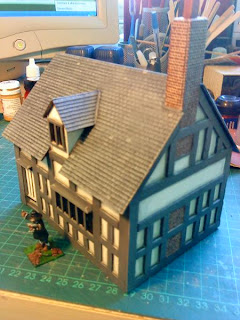Compiling the previous blog entry for the Baxter house I realised I was trying to put too much information into a singular post about a model building. Therefore here is a separate post relating more to the town of Bridgnorth itself.
Looking at the St. Leonard’s Close today you would find it hard to believe that it had ever witnessed scenes of extreme violence. On the 8th March 1646 during the English Civil War Parliamentarian besiegers broke through the churchyard defenses and a running battle developed. The town commander Colonel Billingsley and twenty five of his men were killed defending this area from the Parliamentary forces. Later during the same siege, when the church was then being used by the Parliamentarians as an ammunition store, a shot from the castle caused an explosion that destroyed most of the building and started a fire that damaged a large area of the upper town. The body and tower of this now redundant church are mainly Victorian although some traces of medieval building still survive.

St. Leonard's church, the Richard Baxter house is just round the corner to the left of this picture.
Just a short distance away to the south of the St Leonard’s sits, at a jaunty angle, the town’s castle. In 1642, King Charles I described the view from here at Castle Walk as 'the finest in my domain'. Little remains of the castle apart from the famously tilted (15° off the vertical) Norman stone keep. It always makes me smile thinking about the Parliamentarian engineers seeing the keep as the dust settled, after all their efforts to slight it. I imagine they simply scratched their heads, threw down their pickaxes and walked away either cursing or praising their medieval counterparts.
If you look carefully you may notice the iron hooks on the outside of the left hand wall. It is believed these were added during the ECW siege so that mattresses and other padding could be hung off them to soften the blows from artillery shot coming from the direction of the church.
The TV series Time Team excavated the Castle gardens to the left and behind this picture, looking for any remains of the bailey, and found absolutely bugger all.
On a strange and darker note, fairly recently (2005) papers relating to Operation Sealion were discovered in Germany. These indicated that if Hitler and his Nazi henchmen had conquered Britain Bridgnorth was a proposed location for the German headquarters. Factors such as its central location, good road and rail links, nearby airfield and a small local population were considered to have made it an ideal, and relatively safe, administration centre for the midlands. It’s quite a sobering thought to imagine German jackboots goose-stepping up and down the quintessentially English high street.
View from the Railwaymans Arms looking towards the castle grounds. The keep is immediately to the left of the tallest tree in the background.
On a far less sober note, there are numerous decent pubs throughout the town, but one I would recommend is the Railwaymans Arms. Located on the platform of Bridgnorth station, at the north terminus of the Severn Valley Railway line, it’s very atmospheric even if you don’t particularly like steam trains. Depending on what time you visit it can be like walking into a museum or a film set. And of course the beer is excellent. The pub also gives you a good view of both the castle and the siege earthworks, now called Pan Pudding Hill, built by Henry I in 1102 and located just on the other side of the railway tracks. There is a modern footbridge from the castle gardens over the main road which will take you right to the station.
If you don't want to walk that far then the The White Lion Inn on West Castle Street (yep, near the castle) is also worth visiting.















